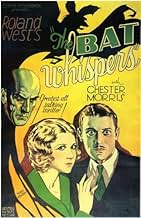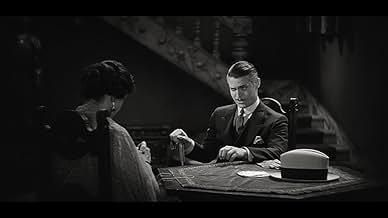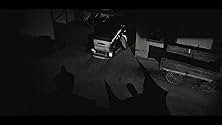AVALIAÇÃO DA IMDb
6,3/10
1,4 mil
SUA AVALIAÇÃO
Adicionar um enredo no seu idiomaA master criminal terrorizes the occupants of an isolated country mansion.A master criminal terrorizes the occupants of an isolated country mansion.A master criminal terrorizes the occupants of an isolated country mansion.
- Direção
- Roteiristas
- Artistas
- Prêmios
- 2 vitórias no total
- Direção
- Roteiristas
- Elenco e equipe completos
- Produção, bilheteria e muito mais no IMDbPro
Avaliações em destaque
No doubt about it, the silent screen acting technique is still present in this early talkie. Everyone behaves as though they had a case of first night stage jitters--and the supposedly comic moments are painfully obvious and tainted with smokehouse ham.
But aside from the theatrics of some of the cast, this is an entertaining and truly spooky old dark house kind of comedy-mystery that was so popular during the '30s and '40s. What is most amazing is the fluidity of the camerawork through the innovative use of miniatures and the camera's ability to zoom forward and slink along the exteriors of an old mansion like a prowling cat. It is worth seeing alone for the atmospheric sets and photography, especially considering that this was filmed in 1930 when sound itself was only two years old.
Only Chester Morris among the performers delivers a really credible performance acceptable by today's standards of acting. The others are way over the top--including Una Merkel and just about all of the supporting players with the exception of William Bakewell.
If you're a fan of Mary Roberts Rinehart stories, you'll enjoy this version of her successful play. It's far superior to the later remake with Vincent Price. Be sure to see this in the newly released Wide Screen Version. It's a pristine transfer from the restoration by the UCLA Film and Television Archive.
But aside from the theatrics of some of the cast, this is an entertaining and truly spooky old dark house kind of comedy-mystery that was so popular during the '30s and '40s. What is most amazing is the fluidity of the camerawork through the innovative use of miniatures and the camera's ability to zoom forward and slink along the exteriors of an old mansion like a prowling cat. It is worth seeing alone for the atmospheric sets and photography, especially considering that this was filmed in 1930 when sound itself was only two years old.
Only Chester Morris among the performers delivers a really credible performance acceptable by today's standards of acting. The others are way over the top--including Una Merkel and just about all of the supporting players with the exception of William Bakewell.
If you're a fan of Mary Roberts Rinehart stories, you'll enjoy this version of her successful play. It's far superior to the later remake with Vincent Price. Be sure to see this in the newly released Wide Screen Version. It's a pristine transfer from the restoration by the UCLA Film and Television Archive.
Based on a play that was filmed four years earlier by the same director this is a wonderful film that is hampered only by the limitations of sound. That said this is probably the best version of the story.
A fiend known as The Bat is lurking around the mansion of a rich family and its up to an intrepid detective to prevent him from getting the goods.
This movie is a lot of fun, with several wonderful performances especially by Chester Morris as the detective.
Interestingly the film was filmed both in the standard aspect ratio and in an early wide screen process (Both are on the DVD). The films are more or less identical, but since they were taken from different takes they both play like two different nights of the same play.
I like this film a great deal and recommend it to anyone who likes the Old Dark House genre.
A fiend known as The Bat is lurking around the mansion of a rich family and its up to an intrepid detective to prevent him from getting the goods.
This movie is a lot of fun, with several wonderful performances especially by Chester Morris as the detective.
Interestingly the film was filmed both in the standard aspect ratio and in an early wide screen process (Both are on the DVD). The films are more or less identical, but since they were taken from different takes they both play like two different nights of the same play.
I like this film a great deal and recommend it to anyone who likes the Old Dark House genre.
Roland West's THE BAT WHISPERS was based on a hugely successful Broadway play, The Bat, widely credited for having created the vogue for thriller plays in the 1920's. (The 1927 production "Dracula" which starred Bela Lugosi on stage was part of the mystery vogue, and led directly to the 1930 Universal film which kicked off the 30's cycle of horror movies). West filmed The Bat in 1926 as a silent, with great success. The 1930 remake was a large production, shot simultaneously in standard 35mm and a new widescreen 65mm process. Theater owners largely rejected the expense of installing 65mm equipment, and most people who saw this film on its release saw the 35mm version.
Among them was Bob Kane, who credited it as a major influence in his creation of Batman in the late 30's. It's easy to see why. This is a stunning looking film (I'm referring to the 35mm version, which I saw at the 2004 UCLA Festival of Preservation) gorgeously photographed by Ray June. In an old dark house where the lights are constantly going off, and lighting is frequently provided by candles, or lightning, bizarre lighting effects start to become the norm, and the dramatic possibilities take off. The director used every conceivable angle to keep things visually lively, mirroring the ridiculous complexity of the plot with a visual complexity that always keeps the viewer slightly off balance.
Much has been made of the sweeping camera moves and the use of miniatures. The miniatures are a bit obvious, but their intent remains effective if you're willing to go with it. (Being willing to "go with it" is pretty much a necessity in general for this film, which was a wild and unrealistic ride in its time, and deliberately so.) The photography benefits from a number of technical innovations, including a lightweight camera dolly invented for this production that allowed the camera to be moved 18 feet vertically in a matter of moments.
The performances - both comic and dramatic characters - are deliberately hokey, very stagey turns that were the standard for this genre. Much of Chester Morris' mugging and squinting, however, are attributable to the violently bright underlighting that was used in his closeups, which eventually scorched his retinas (a condition which became known as Klieg Eye). Within that context, they are wonderful performances. Morris is particularly engaging, as is Grayce Hampton as the patrician Cornelia Van Gorder, the middle-aged spinster who refuses to be scared out of the house. (Hampton appears to be a very capable stage actress, and offers perhaps the most natural performance in the film. She had made one previous film in 1916 and made numerous subsequent ones, usually in bit parts, until she was nearly 80.) Her no-nonsense dowager centers the film perfectly, keeping the other characters (and performances) from plunging completely off the deep end.
The plot? A master criminal, The Bat, is on the loose, a half-million dollars have been stolen from a bank by somebody else, and The Bat is trying to get it. The money has apparently been brought to a lonely mansion in a rural town (apparently somewhere on then-rural Long Island) where a middle-aged woman and her made are renting for the summer. Someone is trying to scare her out of the house, so she has sent for detectives. From there, anything goes.
Among them was Bob Kane, who credited it as a major influence in his creation of Batman in the late 30's. It's easy to see why. This is a stunning looking film (I'm referring to the 35mm version, which I saw at the 2004 UCLA Festival of Preservation) gorgeously photographed by Ray June. In an old dark house where the lights are constantly going off, and lighting is frequently provided by candles, or lightning, bizarre lighting effects start to become the norm, and the dramatic possibilities take off. The director used every conceivable angle to keep things visually lively, mirroring the ridiculous complexity of the plot with a visual complexity that always keeps the viewer slightly off balance.
Much has been made of the sweeping camera moves and the use of miniatures. The miniatures are a bit obvious, but their intent remains effective if you're willing to go with it. (Being willing to "go with it" is pretty much a necessity in general for this film, which was a wild and unrealistic ride in its time, and deliberately so.) The photography benefits from a number of technical innovations, including a lightweight camera dolly invented for this production that allowed the camera to be moved 18 feet vertically in a matter of moments.
The performances - both comic and dramatic characters - are deliberately hokey, very stagey turns that were the standard for this genre. Much of Chester Morris' mugging and squinting, however, are attributable to the violently bright underlighting that was used in his closeups, which eventually scorched his retinas (a condition which became known as Klieg Eye). Within that context, they are wonderful performances. Morris is particularly engaging, as is Grayce Hampton as the patrician Cornelia Van Gorder, the middle-aged spinster who refuses to be scared out of the house. (Hampton appears to be a very capable stage actress, and offers perhaps the most natural performance in the film. She had made one previous film in 1916 and made numerous subsequent ones, usually in bit parts, until she was nearly 80.) Her no-nonsense dowager centers the film perfectly, keeping the other characters (and performances) from plunging completely off the deep end.
The plot? A master criminal, The Bat, is on the loose, a half-million dollars have been stolen from a bank by somebody else, and The Bat is trying to get it. The money has apparently been brought to a lonely mansion in a rural town (apparently somewhere on then-rural Long Island) where a middle-aged woman and her made are renting for the summer. Someone is trying to scare her out of the house, so she has sent for detectives. From there, anything goes.
A tour-de-force of chases, shootouts, and robbery, as "The Bat" terrorizes a city, and particularly the renters of a mansion where he makes his hideout. Nearly everybody is a suspect, but the key lighting pretty much gives it away. Nonetheless, West keeps the pace moving so fast that we don't really have time to stop and think about much of anything. Features West's trademark effects with miniatures and wires.
Some remarkable photography (in 65mm, no less) in the disappearing silent gothic tradition makes this movie a link from the newly emerging horror scene to the old "haunted house with criminals" genre into which it more properly falls.
"Goofy gothic" excellence.
Some remarkable photography (in 65mm, no less) in the disappearing silent gothic tradition makes this movie a link from the newly emerging horror scene to the old "haunted house with criminals" genre into which it more properly falls.
"Goofy gothic" excellence.
This is a great old black and white mystery/suspenser. If you have the capacity to enjoy films of the 30's and 40's and you like mysteries and fine film craftsmanship, see his movie. Chester Morris is very good as the lead. The plot is relatively true to the Hopwood/Rinehart original screenplay. The setting is an old mansion with a spinster and family members terrified by a super criminal known as the Bat. They get outside help, but the Bat strikes anyway. Who is the Bat? What does he want in the old mansion? The story answers those questions in a most old-fashioned, entertaining manner. Of the three movie versions of the Bat, the 1926 silent, the 1950's Vincent Price/Agnes Moorhead version, and this one, this is the best.
Você sabia?
- CuriosidadesOne of only a handful of films to be shot in the widescreen Magnifilm 65mm format (other studios were also experimenting with other wide formats at the time). The expense of upgrading theaters with new screens and projectors - after just having to install sound equipment - coupled with the Depression and the December 1930 edict from the MPPDA that the film industry not cause "the public's curiosity to be aroused about any new innovations for at least two years" effectively killed the new format. Widescreen formats did not return until the middle of the 1950s out of the necessity to compete with television.
- Erros de gravaçãoAfter the bank robbery, there is a obvious slot in the "road" where the miniature car travels.
- Citações
The Unknown: What I'd like to know is how did you get the dope from headquarters on this case?
Detective Anderson: The same way I get everything, with my mind. I've got the greatest brain that ever existed.
- Cenas durante ou pós-créditosAfter the film an actor comes onto a movie house stage and implores the audience to withhold the identity of the bat from family and friends so they can also enjoy the movie.
- Versões alternativasThis film was shot in two versions with a different director of photography for each. One is in standard 35mm and the other in an early 65mm process. The 65mm version is considered "stagebound" (it was actually based on a popular play) while the 35mm version is considered more "cinematic". Prints of both versions still exist.
- ConexõesFeatured in Cinemassacre Video: Bat-a-Thon (2008)
Principais escolhas
Faça login para avaliar e ver a lista de recomendações personalizadas
- How long is The Bat Whispers?Fornecido pela Alexa
Detalhes
- Tempo de duração1 hora 24 minutos
- Cor
- Mixagem de som
Contribua para esta página
Sugerir uma alteração ou adicionar conteúdo ausente
































